Engine Oil and Oil Filter
Initially early automotive engine designs did not use any oil filtration.
The development of pressure lubrication brought about a need for some type of filtration to protect the oil pump from damage and excessive wear.
At first only simple wire meshes or screens were used in the oil pump intake, some were permanent, while some designs permitted removal and periodic cleaning. In most cases the "oil filter" was reusable after cleaning, usually in kerosene.
In 1924 first full pressure lubrication system, with an oil filter, became available on a high volume production engine.
Some engines used oil filters ONLY in "by-pass" and not in main flow of pressurized oil.
The first use of a full flow oil filter on mass production vehicles occurred in 1946.
The "spin-on" oil filter design was introduced in 1950's.
Between 1968 to 1971 "spin-on" oil filters were almost universally used on all US and most European and Japanese engine designs.
Many successful and popular engine designs (VW, FIAT) did not use any oil filters until 1970's.
All automotive engines, whether gasoline or diesel, now come with standard oil filters of some kind.
Motor Oil used in Internal Combustion Engines (ICE) has several functions:
- Lubrication
- Cooling
- Sealing
- Control
- Absorbs contaminants
- Suspends wear particles
- Suspends soot
Explaining how Engine works and the details of the above mentioned functions is beyond the scope of this article.
Our objective is to present different design details and how they relate to Motor Oil and Filter Change.
Specifically following items are considered:
- Ability to drain Motor Oil completely
- Location of Oil Filter and ease of replacing it
- Ease of checking the Motor Oil level
- Low Oil Warning
IDEAL Design
In a perfect and ideal world where vehicles are built and designed to last "forever" and are easily and quickly maintained, the IDEAL Design would have these features:
- Easy to access drain plugs are provided on
- Engine Oil Pan
- Oil Tank (if so equipped)
- Oil Cooler
Complete Oil drain is possible without any special tools or equipment.
However once you do drain the Oil, you have to have way to fill up the system with fresh Oil.
This of course requires:
- Easy to access filler
For Engine longevity and for reliable operation a good Oil Filter is also a must.
The best design is:
- Easily accessible
- Spin-On type
For Engine longevity and for reliable operation a well designed Dipstick is a must.
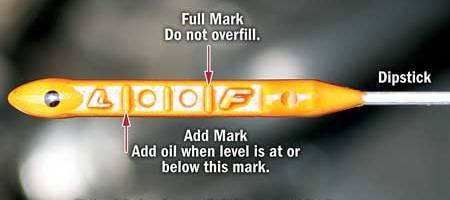
Example of IDEAL Motor Oil Dipstick
The best design is:
- Easily accessible
- Calibrated for both MIN and MAX levels, while both HOT and COLD
For Engine longevity and for reliable operation a well designed "Low Oil" Warning System is desirable.
The best design is:
- Accurate
- Functions both when vehicle is in motion or when it is stationary
Comment:
Unfortunately, to our knowledge there are very few vehicles currently manufactured anywhere in the World that have ALL the features of this IDEAL design !
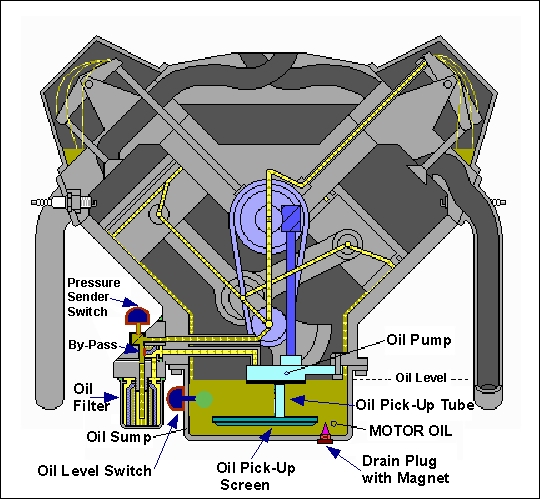
Example of IDEAL Motor Oil System
Graphics above illustrates some of the features of IDEAL Motor Oil System.
- Deep Oil Pan
- Holds one or two more Liters than necessary for safe engine operation
- Oil Pick-Up
- Fine Screen on the pick up prevents damage to Oil Pump
- The pick up is at least 30 millimeters from Oil Pan bottom
This prevents particles that settled on the bottom from re-entering onto oil circulation
- Drain Plug
- Located at the lowest point of the Oil Pan, when vehicle is level
- Equipped with Strong Magnet to trap any Ferro-magnetic particles
- Oil Level
- Below Oil Pan Gasket
to minimize oil seepage when vehicle is stationary
- Below Oil Pan Gasket
- Low Oil Level Warning Switch
- Activates when Oil Level is one Liter below "FULL"
- Oil Filter
- Mounted VERTICALLY
with gasket upright
- Mounted VERTICALLY
- By-Pass
- Mounted in Oil Filter adapter
- Allows for Oil By-Pass when filter is clogged or Oil too thick when cold
- Prevents Filter Media damage
- Oil Pressure Sender
- Provides variable signal for Gauge
- Provides LOW PRESSURE signal for Warning Light
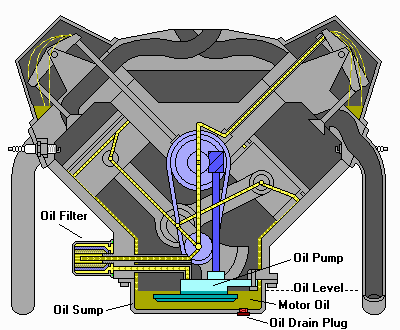
Example of "compromised" Motor Oil System
Graphics above illustrates some of the features that were deleted from the IDEAL Motor Oil System, due to the need to increase ground clearance or alternately reduce the hood height on the vehicle.
- Oil Sump
- Depth was reduced
Extra Oil Capacity eliminated
- Depth was reduced
- Low Oil Level Warning Switch
- Reduced Pan Depth prevents installation
- Drain Plug
- Magnet is Eliminated
Cost reduction
- Magnet is Eliminated
- Oil Filter
- Mounted HORIZONTALLY
less Ideal Orientation - Increases Ground Clearance
- Eliminates Oil Filter Adapter
- By-Pass is moved INTO the filter
Reliable Oil Pressure regulation is compromised
The burden is now moved from Engine OEM to Filter Manufacturer
- Mounted HORIZONTALLY
- Oil Pressure Sender
- Eliminated - Gauge can not be used
- Replaced with Switch ONLY mounted elsewhere on the engine
Provides LOW PRESSURE signal for Warning Light
WORST Design
The absolutely WORST possible design is such that NONE of the points listed in the IDEAL design are present - NONE !
Some current models of All Terrain Vehicles (ATV) made in China are just like that, but fortunately most highway capable vehicles have at least some of the desirable features.
Checking of Motor Oil is difficult, there is no provision to completely drain and refill the Oil, Oil filter access is difficult, or Oil Filter is undersized for the application.
These are the common traits of a POOR Design.
Conclusion:
Vehicles so designed are intended to be "disposable", low cost to manufacture (but not necessarily low cost to purchase or own), and to be seldom maintained.
BAD Design
No Oil Filter
Many successful and popular engine designs (VW, FIAT) did not use any oil filters until 1970's.
Today while highway capable vehicles do have Oil Filters, there are still many engines produced that do not have any filtration !
Examples:
- ATV
- Low cost Motorcycles
- Garden Tractors
- Generators
- Emergency Pumps
Poor Drain Plug Access
More and more new vehicles have complex under panning, in the name of improved aerodynamics, and thus getting better highway fuel economy.
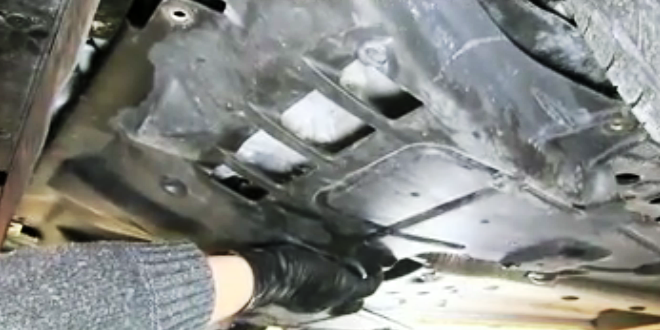
Example of Under Pan that must be completely removed
(After removing 2 Screws, 6 bolts and 2 plastic rivets)
in order to access the Drain Plug.
Unfortunately in many cases no thought was given in the design for the fact that Motor Oil will need to be drained at least sometimes.
If removal of under pan was not enough to make a Simple Oil Change difficult and time consuming task, some OEMs like HONDA and TOYOTA, especially on their Hybrid Models also design in difficult to remove and easy to damage special hardware that attaches such under pans to the vehicle.
Some LEXUS Hybrid Models for example have as many as 14 different fasteners of 6 different types !
Inexperienced mechanic may not be ever able to re-install such under pan back properly.
It is open to debate if TOYOTA intentionally designs this way, in order to punish any LEXUS owner that ever goes to "Quick Oil Change Outfit", but it sure works !
To remove and re-install such pan even for a skilled technician, can easily take over one hour.
On few vehicles the POOR design goes as far as making the complete under pan removal impossible, and thus Oil Drain can only be performed if the vehicle is elevated on a lift.
Difficult Dipstick
Dipstick design problems are also quite common on many new engine designs.
They may range from inability to find the Dipstick in the first place, such as making it part of the Filler Cap (GM), hiding it under difficult or imposable to remove "fancy" engine cover (common on many "luxury cars"), to marking it with "strange" handle colors like: Red, Orange, Purple or Blue.
More and more new vehicles with Automatic Transmissions are leaving the assembly line with absolutely no dipstick !
This is not "oversight" or poor workmanship of the assembly worker, the dipstick was simply LEFT OUT in the design stage
The excuse is that the vehicle is built so good that there NEVER will be any leaks, and thus checking the ATF level is not necessary - EVER !
Fortunately all automotive engines, unlike the Automatic Transmissions, still have some kind of dipstick, even if it is hard to find or "impossible" to read.
On some engines the dipstick design is so difficult to "read" that a special procedure is required to get correct Engine Oil Level "estimate", while in other designs the Engine Oil is "all over" the dipstick end, or No Oil can be seen!
SUBARU boxer engines are famous for difficult to read dipsticks, while FORD Focus engines will indicate "low" unless a proper procedure is followed, which of course is NOT disclosed in the Owner's Manual.
Some engines like for example FIAT Turbo (see below) have dipstick, that is so poorly designed that it is rendered completely useless!
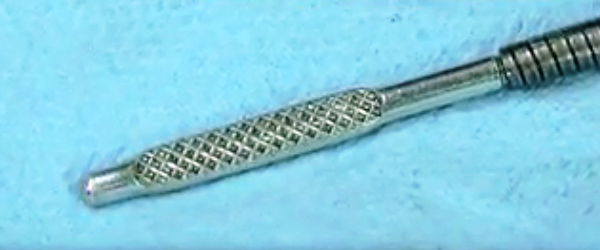
Example of POOR Motor Oil Dipstick - NO OIL
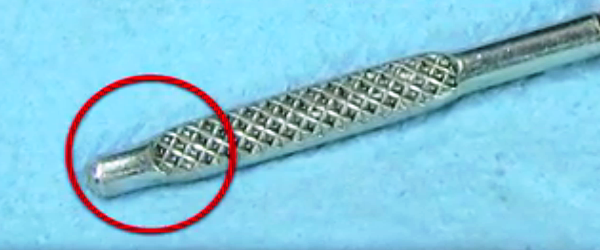
Example of POOR Motor Oil Dipstick - LOW OIL LEVEL
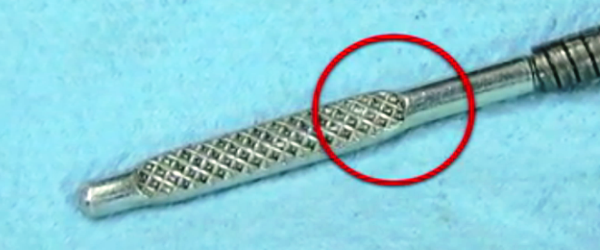
Example of POOR Motor Oil Dipstick - OIL LEVEL TOO HIGH
As seen above, even at 500% close up image magnification, one can not really tell with Fresh Clean Oil if the Oil Level is proper or not.
Checking of Motor Oil should not be difficult task, that requires a special "expert" training !
So if you are shopping for a new vehicle, open the hood and locate and check the dipstick, if you can not find it,
or can not "read" it, do not buy the car.
No ability to FULLY Drain
In the old days no one has ever envisioned to design an engine from which most of the oil would not be possible to drain out !
Today such designs are however common and there seldom is any provision to 100% drain and replace all the Oil.
In most designs about 10 to 15% of the "OLD OIL" will remain.
But more and more engines, especially Turbo Charged ones, also have complex oil cooling systems, with Coolers, Heat Exchangers and lot of piping in between them and the Engine.
Some of these "systems" are thermostatically controlled, and only "open" when the Motor Oil is in excess of 190°F.
Cooler does not have drain cock, and the Cooler Lines are not designed to be disconnected for servicing.
The drain and flush services that some service outlets will try to sell you for hundreds of dollars are totally ineffective and it is absolutely impossible to drain ALL of the Oil completely, irrespective of what their advertisements will claim.
Some DOHC engines are intentionally designed to hold as much as a Liter or more of Oil in each Cam Housing, so that oil is available for cam and valve tappet lubrication immediately upon starting, this prevents severe wear in sub-zero temperatures when oil takes a long time to flow to the top of the engine.
Of course if you have engine that holds 6 to 7 Liters of Motor Oil, but only 4 to 5 Liters can be drained, a very high percentage of the "OLD OIL" will remain.
Sometimes this may be as much as 35% of the total Engine Oil Capacity !
If one intents to keep such new vehicle "forever" then multiple and frequent Oil Changes are required and they must be done long before the Oil deteriorates to such a point where it is no longer serviceable.
No "Low Oil" WARNING
It is actually amazing that OEM's will spend billions on research how cars can practically drive themselves, but completely FAIL to add $15 float and warning light on the dash to inform the driver that the Motor Oil Level is "LOW".
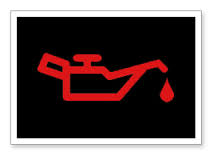
Sure many vehicles have the "RED" ISO "OIL CAN" Warning Light when there is ABSOLUTELY NO OIL PRESSURE = thus engine damage is already being done, but not all !
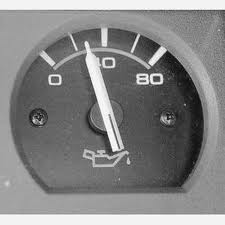
On many GM trucks there is Oil Pressure Gauge, but unless one keeps looking at it all the time when you drive, if the Oil Pressure drops suddenly for what ever reason, in most cases serious engine damage is done before or if the driver even notices that the reading is ZERO.
When average vehicle is over $30,000 and typical engine may cost as much as $9,000 or more to replace, the lack if a "LOW OIL LEVEL" Warning System is simply not excusable.
If you are shopping for a new vehicle just refuse to buy one if it does not feature such a system, and make sure you let the Sales Manager know WHY you are NOT buying such vehicle.
![]()
Currently this page is still under development, so please check back periodically for new
additions.